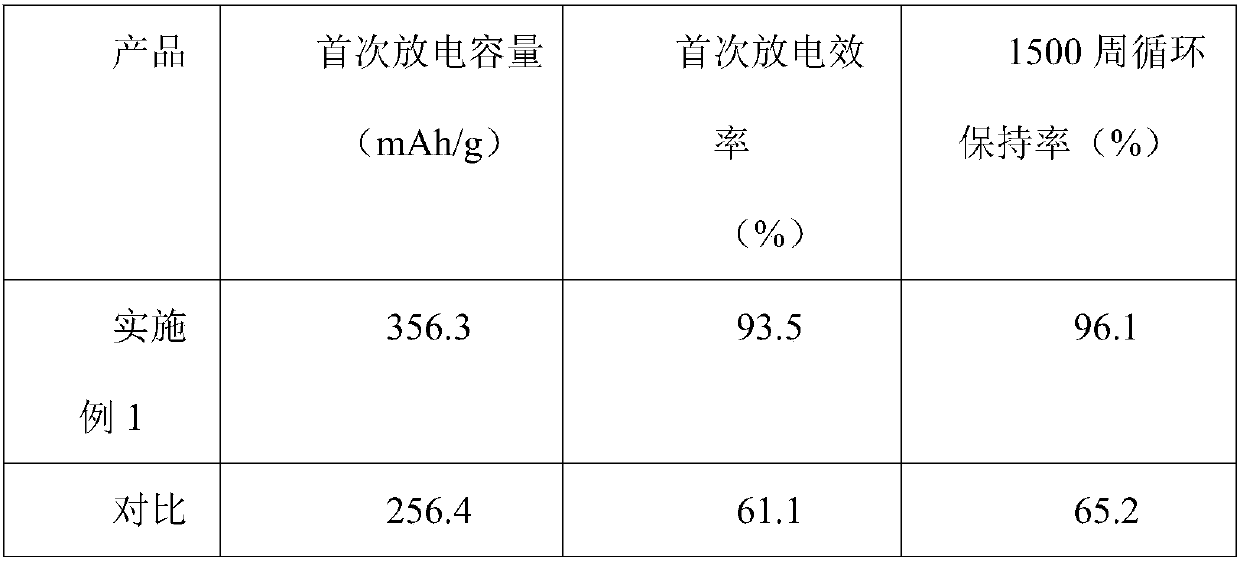Preparation method of soft/hard carbon modified anode material for lithium ion batteries
A lithium-ion battery and negative electrode material technology, applied in battery electrodes, secondary batteries, circuits, etc., can solve problems such as large irreversible capacity, hinder negative electrode materials, and reduce efficiency, and achieve improved discharge efficiency and cycle stability, excellent rate. performance and low temperature performance, the effect of increasing tap density
- Summary
- Abstract
- Description
- Claims
- Application Information
AI Technical Summary
Problems solved by technology
Method used
Image
Examples
Embodiment 1
[0032] Using natural graphite fine powder as raw material (average particle size D50 is 4.65μm), petroleum pitch (softening point: 100°C) as soft carbon precursor, phenolic resin as hard carbon precursor (softening point: 110°C), the quality of the three The ratio is 10:3:3 respectively, and they are added to the reactor for stirring, the temperature is 320°C, the stirring time is 6 hours, and then cooled.
[0033] The powder obtained after cooling is sieved through a 200-mesh sieve, and the large particles on the sieve are crushed, and the powder obtained after crushing is sieved again, and then the powder under the sieve is stirred and mixed for high-temperature graphitization .
[0034] The powder obtained after graphitization is sieved through a 200-mesh sieve, the under-sieved powder is taken, and a small amount of large particles on the sieve are crushed and returned as graphite raw materials for recycling.
[0035] According to the molar ratio Ti:Si:C=2.5:2:800, weigh ...
Embodiment 2
[0038] Natural graphite fine powder is used as raw material (average particle size D50 is 6.25μm), coal tar pitch (softening point is 150°C) is soft carbon precursor, epoxy resin is hard carbon precursor (softening point is 100°C), the three The mass ratio is 10:4:4, respectively, and they are added to the reactor for stirring at a temperature of 450°C, and the stirring time is 7 hours, and then cooled.
[0039] The powder obtained after cooling is sieved through a 250-mesh sieve, and the large particles on the sieve are crushed, and the powder obtained after crushing is sieved again, and then the powder under the sieve is stirred and mixed for high-temperature graphitization .
[0040] The powder obtained after graphitization is sieved through a 200-mesh sieve, the under-sieved powder is taken, and a small amount of large particles on the sieve are crushed and returned as graphite raw materials for recycling.
[0041] According to the molar ratio Ti:Si:C=3:2:1000, take ethyl...
Embodiment 3
[0044] Artificial graphite fine powder is used as raw material (average particle diameter D50 is 5.96 μm), petroleum pitch (softening point is 250°C) is used as organic carbon source, furan resin is hard carbon precursor (softening point is 90°C), the mass ratio of the three The ratio is 10:5:5, respectively, and they are added to the reactor for stirring, the temperature is 500°C, the stirring time is 8 hours, and then cooled.
[0045] The powder obtained after cooling is sieved through a 200-mesh sieve, and the large particles on the sieve are crushed, and the powder obtained after crushing is sieved again, and then the powder under the sieve is stirred and mixed for high-temperature graphitization .
[0046] The powder obtained after graphitization is sieved through a 200-mesh sieve, the under-sieved powder is taken, and a small amount of large particles on the sieve are crushed and returned as graphite raw materials for recycling.
[0047] According to the molar ratio Ti:...
PUM
| Property | Measurement | Unit |
|---|---|---|
| The average particle size | aaaaa | aaaaa |
| Softening point | aaaaa | aaaaa |
| Softening point | aaaaa | aaaaa |
Abstract
Description
Claims
Application Information
 Login to View More
Login to View More - R&D
- Intellectual Property
- Life Sciences
- Materials
- Tech Scout
- Unparalleled Data Quality
- Higher Quality Content
- 60% Fewer Hallucinations
Browse by: Latest US Patents, China's latest patents, Technical Efficacy Thesaurus, Application Domain, Technology Topic, Popular Technical Reports.
© 2025 PatSnap. All rights reserved.Legal|Privacy policy|Modern Slavery Act Transparency Statement|Sitemap|About US| Contact US: help@patsnap.com



